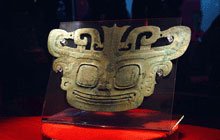
 The museum at Sanxingdui, nearly 30 miles north of Chengdu, presents one of China 's most splendid, if mysterious, archeological finds. In 1929, when a collection of 400 multicolored jades were accidentally uncovered by a farmer here, this site was recognized as having rich potential; digs were organized in the 1930's by Gei Weihan, an American-Chinese professor, and then again in 1960's under Chinese direction. It wasn't until July 1986 however, that archaeologists discovered the two sacrificial pits containing hundreds of elaborate ivory, jade, gold and bronze artifacts that were to launch Sanxingdui onto the world stage. Intricate gold and bronze castings, dating from the first millennium BCE as well as ceramics from the third millennium BCE, revealed the remnants of a technologically-proficient ancient society and questioned the prevailing orthodoxy of Chinese culture originating in the Yellow River basin. Here was proof of a sophisticated culture from the Chengdu Plain that seemed to have little to do with its contemporary counterpart at Anyang in Hebei province (south of Beijing), but something to do with the cultures further down the Yangzi River.
The museum at Sanxingdui, nearly 30 miles north of Chengdu, presents one of China 's most splendid, if mysterious, archeological finds. In 1929, when a collection of 400 multicolored jades were accidentally uncovered by a farmer here, this site was recognized as having rich potential; digs were organized in the 1930's by Gei Weihan, an American-Chinese professor, and then again in 1960's under Chinese direction. It wasn't until July 1986 however, that archaeologists discovered the two sacrificial pits containing hundreds of elaborate ivory, jade, gold and bronze artifacts that were to launch Sanxingdui onto the world stage. Intricate gold and bronze castings, dating from the first millennium BCE as well as ceramics from the third millennium BCE, revealed the remnants of a technologically-proficient ancient society and questioned the prevailing orthodoxy of Chinese culture originating in the Yellow River basin. Here was proof of a sophisticated culture from the Chengdu Plain that seemed to have little to do with its contemporary counterpart at Anyang in Hebei province (south of Beijing), but something to do with the cultures further down the Yangzi River.
What does the slender, finely-worked gold scepter represent? What were the variously-sized, intriguing gold-plated bronze masks for? What do the magnificent bronze trees harboring strange birds, sun gods and other figures indicate? Not only can scholars not agree in their interpretations of these artifacts and symbols, they cannot even say which ancient culture of approximately three thousand years ago is represented by them.
Some say Sanxingdui is the forerunner to the later Shu culture (romanticized in the novel Three Kingdoms), others see strong central Asian influences. Whichever of those it may be, a vibrant artisanal connection with the bronze-working cultures of northern Thailand and southern Yunnan seems certain. Although many of the faces do not look especially Chinese, some of the bronzes carry Chinese patterns. What is remarkable is that Chinese records, usually so all-encompassing of anything that their brush could touch, are silent – we really just do not know. Another unknown is some of the technology used in the production of these cultural artifacts – without diamond-saws how on earth did they cut the jade so smooth?
What is beyond doubt is the quality of the magnificent bronzes – the strange huge mask with the protruding eyes, the enchanting shaman figure that may have once held an elephant tusk in his capacious hands, and the birds and other totemic animals of the 'divine trees', as well as other works.